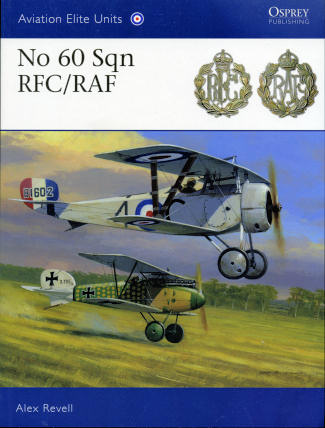 There have
been many famous squadrons in the air arms of many nations over the course of
aviation time. Of of those one does not think about too often is 60 Squadron
RFC/RAF. This unit was one of the early pursuit units to operate in France being
formed in 1916 and serving almost continuously until the end of the war. Like
most units of the time, they were continually moving from one location to
another as the needs of war dictated. Some areas were nearly luxurious with
permanent buildings for planes and personnel, while others were merely a
collection of tents.
There have
been many famous squadrons in the air arms of many nations over the course of
aviation time. Of of those one does not think about too often is 60 Squadron
RFC/RAF. This unit was one of the early pursuit units to operate in France being
formed in 1916 and serving almost continuously until the end of the war. Like
most units of the time, they were continually moving from one location to
another as the needs of war dictated. Some areas were nearly luxurious with
permanent buildings for planes and personnel, while others were merely a
collection of tents.
During their time in war, they claimed over 400 enemy
aircraft, though they also lost 57 of their own in combat with some dozen others
perishing in accidents. Some 25 pilots claimed enough aircraft to be considered
an ace while flying with 60 Squadron. Others went to other units and increased
their score even more.
Two of the more memorable high-scoring pilots was Albert
Ball, who had 31 victories and Billy Bishop who claimed 47 while with the unit.
However, Bishop's score is one that is often in question. Bishop's claims were
generally made when he went out alone and there was no one around to verify
them. Post war research in German files has shown that most of these lone claims
did not match the losses in German records. As an example, a flight where Bishop
claimed three planes, the Germans had no losses. While over-claiming is pretty
well standard stuff, it is felt by many that Bishop took it to a new level.
During their operational periods, 60 Squadron went from
Morane-Saulnier Type N ('Bullets') to Nieuport 23s, to the Se.5. The Bullet was
probably the most dangerous of the types they flew as initially they were
underpowered and with a larger engine, they became more difficult to fly. Still,
pilots were able to fly them successfully until totally outclassed by the latest
German design, whereas they moved to something more able to handle the
opposition.
In line with other books in this series, we get a pretty much
day to day look at the operations of the units. This includes pilot reports and
other first hand accounts. Adding to the interest are a bevy of excellent period
photos of the pilots, ground crews and the aircraft they flew. Of course, there
are several pages of superb color profiles based on the photos in the book.
It all makes for an outstanding look at this fine British
unit and a book I know you will enjoy reading.
October 2011
For more on the complete line of Osprey books,
visit www.ospreypublishing.com. In the US, it is
Osprey Direct at 44-02 23rd St, Suite 219, Long Island City, NY 11101., where you can
get a catalogue of available books.
If you would like your product reviewed fairly and quickly, please contact
me or see other details in the Note to
Contributors.
 There have
been many famous squadrons in the air arms of many nations over the course of
aviation time. Of of those one does not think about too often is 60 Squadron
RFC/RAF. This unit was one of the early pursuit units to operate in France being
formed in 1916 and serving almost continuously until the end of the war. Like
most units of the time, they were continually moving from one location to
another as the needs of war dictated. Some areas were nearly luxurious with
permanent buildings for planes and personnel, while others were merely a
collection of tents.
There have
been many famous squadrons in the air arms of many nations over the course of
aviation time. Of of those one does not think about too often is 60 Squadron
RFC/RAF. This unit was one of the early pursuit units to operate in France being
formed in 1916 and serving almost continuously until the end of the war. Like
most units of the time, they were continually moving from one location to
another as the needs of war dictated. Some areas were nearly luxurious with
permanent buildings for planes and personnel, while others were merely a
collection of tents.